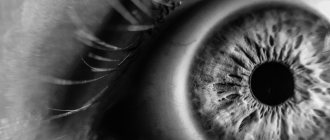Flashes in the eyes are a false sensation in which a person sees luminous objects of various sizes and shapes. As a rule, these are flickering spots, lightning, balls, sparks.
Lightning before the eyes is not an independent disease. This is a symptom that, depending on the circumstances, may indicate harmless eye fatigue or cervical osteochondrosis, or a serious eye catastrophe - retinal detachment. It is one of the most common complaints of patients and, as a rule, is accompanied by another symptom - spots in front of the eyes, the appearance of a “curtain”.
Fig. 1 Posterior vitreous detachment (PVD) is one of the common causes of lightning in the eyes (not dangerous)
What are floaters before the eyes?
Between the retina and the natural lens is a small cavity that is filled with a gel-like substance called the vitreous.
It attaches directly to the macula, optic nerve and blood vessels. The strongest attachment is at the base of the gel-like structure, and the weakest along the retinal microvessels. It is a hydrated extracellular matrix consisting mainly of water (99%), collagens and hyaluronan (1%), organized into a homogeneously transparent hydrogel. Its volume increases during the first decade of life, remains stable until age 40, then begins to gradually decrease.
The cellular composition consists of hyalocytes, fibrocytes, macrophages, laminocytes, Müller cells and microglia. As the hydrogel ages, it gradually degenerates into a more fluid state (synchisis), with 20% liquefaction at 18 years of age to more than 50% at 80.4 years of age. This is accompanied by an increase in the mass of light-optically dense microstructures (syneresis). These inclusions, often called septa, lamellae, membranes and thin tufts, appear to be composed of natural collagenous material and gradually increase in density and irregularity.
Interesting fact
It is known that the US President, Theodore Roosevelt, suffered from retinal detachment due to an injury. As a result, he practically could not see with his left eye. Despite this restriction, Roosevelt continued to make his famous speeches by looking at small cards. Only in his case, the text had to be printed in large letters, and it was not uncommon for one speech to take up to a hundred of these cards. This, in turn, caused significant inconvenience to the president, until one day such a stack of thick paper cards literally saved his life. During an attempt on his life, a bullet pierced the glasses case and passed through these sheets, losing its destructive power. Roosevelt was surprised for a long time by such a happy occasion.
Reasons for the appearance of floaters before the eyes
To understand the problem, you need to focus on anatomy and physiology. In youth and children, the intraocular gel located in the posterior chamber is transparent. Its unique physical and chemical state is maintained due to a certain chemical composition and complex structure of biomolecules.
Under the influence of various aggressive factors, it becomes non-functional, the molecules lose their organized architecture and fall apart into fragments. This has a significant impact on the biological composition and volume of the glassy substance. Small inclusions appear that lack optical transparency. The perception of floating objects occurs both from direct visualization of material condensates and from liquefied vitreal pockets that impede the passage of light rays. Patients describe a "grey, silhouette-like or web-like" artifact, which is characterized as a short period of constant pulse after eye movement has stopped.
This pathology is called in ophthalmology – destruction of the vitreous body. And floating microparticles are perceived by the individual as flying midges or cobwebs settled on the nose. In the absence of gaze fixation, they flash quite intensely and flicker quickly, and then slowly swim in the opposite direction. Blood clots, accumulations of tumor cells, pigment crystals, and protein molecules cast a shadow on the retina.
A similar nosology is observed if a sudden hemorrhage occurs in the jelly-like body, a medicine or a foreign substrate gets into it. Flickering is quite common in the population, but historically it has not been considered a serious medical problem worthy of therapeutic intervention. This is partly because diagnosis is largely based on subjective self-assessment.
Conditions such as diabetes and myopia accelerate liquefaction and the formation of intravitreal aggregates.
Visual impairment from drifting cellular debris can significantly impair quality of life, even if it does not directly affect light perception.
Let's sum it up
Of course, when a person is not bothered by any deviation, he can put up with such an inconvenience for a long time. And it is not uncommon, when such inconveniences concern health, a person may put off going to the doctor until the last minute, self-medicating. In the case of retinal detachment, this tactic is very detrimental to vision. The sooner the patient seeks help, the faster surgical treatment will be performed, which means the chances of restoring vision will increase. And if a few decades ago retinal detachment was a death sentence, today it is a completely solvable problem with a high probability of a favorable outcome. The main thing is not to delay and be determined to preserve your vision.
When is it necessary to visit a doctor?
Destructive processes in most cases are irreversible and are associated with the natural aging of the human body. They most often manifest after 40 years of age. But recently, metamorphoses have been detected in young girls and boys. Degenerative molecular rearrangements of hydrocomplex fibrils lead to localized accumulations. In the filamentous form of destruction, the plexuses can stick together, become denser and provoke visions in the form of transparent threads. After the fibers die, they produce a “jellyfish” or “spider” image; strange shadows block the ability to see clearly. The dense collagen matrix interferes with the transmission of photons to the retina.
The granular type of compaction manifests itself if cells—hyalocytes—penetrate the collagen fibers. Suddenly, floaters in the form of dots and rings are visible. In this situation, consultation with a doctor is required. It is best to immediately be examined by an ophthalmologist to minimize the risk of permanent vision loss.
According to eye doctors, a serious problem occurs when the gel-like substance partially separates from the back wall of the eyeball.
Many people complain of periodic bright flashes and fire-like flickering, as well as an increase in the number of floating floaters. Clinical symptoms are provoked by a uniform flow around the ring of a gel-like substance around the optic nerve.
As an individual grows older, the volume of the gel decreases, and it easily moves in the internal environments of the light-optical system. Sometimes it practically goes beyond its edges.
Pathological symptoms occur in the following situations:
- Traumatization of the organ;
- Myopia;
- Uveitis;
- Pregnancy;
- Lack of vitamins and microelements;
- Acute and chronic inflammation;
- Metabolic imbalance;
- Diabetes;
- Hemorrhagic syndrome;
- VSD and arterial hypertension;
- Anemia;
- Against the background of emotional overstrain and constant stress;
- Cervical osteoarthritis;
- Malignant neoplasm in the occipital lobe;
- Acute and chronic intoxication;
- TBI.
With advanced cervical osteochondrosis, the degenerative cascade triggers the mechanism of drying out of the intervertebral disc, which leads to loss of height of a certain part of the spine. This provokes ventral angulation and possible loss of lordosis with compression of neural and microvascular structures. Poor blood supply to the head leads to the appearance of black spots.
Diagnostics
Diagnosis of flashing light in the eyes will include an eye examination. The doctor will ask about symptoms and any possible causes, such as a recent blow to the eye. The ophthalmologist will visually check the eye for signs of injury and will also look for hallmark signs of Stickler syndrome, such as a cleft palate.
An eye examination may include the use of a special lens to examine the retina. Your doctor may do an extensive eye exam to check for cytomegalovirus retinitis. This involves using eye drops to dilate the eyes for examination.
Treatment of floaters before the eyes
Optical coherence tomography (OCT) is used as a means to objectively and qualitatively assess the visual impact of opacities. Ultrasound provides quantitative measurements of echo density. This is useful in assessing the severity of the disease and response to therapy. Indirect ophthalmoscopy is designed to identify possible micro-tears, timely correction and prevent detachment.
Considering the fact that artifacts can be a dangerous symptom of various somatic ailments, it is very important to conduct a thorough diagnosis and identify the underlying etiology. The next stage will be treatment of the diagnosed nosology.
Very rarely, unpleasant flickering stops on its own. Most often, the turbidity shifts and leaves the visible zone, but does not completely disappear.
At the current level of development of medicine, there are no sufficiently effective drugs that would help remove circulating bodies. However, there are medications that help activate local metabolism in the optical apparatus and promote the gradual dissolution of particles and inclusions.
If the situation is caused by damage to the retina, then surgical repair of the tears is indicated. Microsurgery is performed on an outpatient basis at the Fedorov Clinic under local anesthesia. This significantly shortens the rehabilitation period.
Floaterectomy:
Laser vitreolysis technology
— surgical correction is carried out with a neodymium laser. The surgeon, using special equipment, targets microinclusions and eliminates them. By focusing short, intense pulses of laser energy into opaque areas, the temperature of these limited spots can be raised to several thousand degrees Kelvin. At this temperature, plasma is formed and the accumulations are destroyed, and in some cases the symptoms can be successfully eliminated. This technique is unsafe, has not been fully studied and causes a large number of side effects. The effectiveness of a YAG laser session can be improved if performed by an experienced surgeon;
Vitrectomy
is a medical intervention that involves extracting the entire vitreous. A sterile saline solution will be placed in its place. This manipulation is not harmless, controversial and sometimes leads to cataracts, hemorrhages, and retinal detachment. The most serious risk of intraocular surgery is endophthalmitis, and in the context of vitrectomy it has become of paramount importance.
Modern instruments and microsurgical techniques have led to shorter operating times and faster recovery.
If the standard technology of ophthalmic surgery is not violated, then patients are satisfied with the final result.
Symptoms of the disease
The main danger of deviation is that the initial moment of detachment cannot be noticed. There is no pain or discomfort, and minor visual disturbances are often perceived as the result of simple overwork. The very first symptoms of progressive detachment, which may indicate detachment, may be bright flashes of light. They are often compared to silent flashes of lightning during a thunderstorm. It is not uncommon for hemorrhages to form in the field of vision. In this case, multiple black dots appear - flying spots in front of the eyes. Further, if the process progresses, a “veil” appears before the eyes, and then a decrease in vision follows. When moving the head, tilting and blinking, the situation can change, both for the worse and for the better. After sufficient rest or a night's sleep, you may notice a disappearance or reduction in these symptoms. This is due to the fact that the retina straightens during sleep and temporarily occupies the correct position, while the amount of accumulated fluid between its layers decreases. However, this period of improvement does not last long, and after a short time they return again with even greater force.
Preventive actions
The presence of structural elements of the light-optical apparatus depends on general well-being. Prevention of myodesopsia involves a healthy lifestyle. The neuropsychological state, a balanced diet and regular physical activity are of great importance. It is advisable to give up smoking and drinking alcoholic beverages, and promptly cure ophthalmological pathology.
A person should be extremely careful about his health and wear sunglasses. If cloudiness appears or the image is blurry, immediately contact an experienced ophthalmologist in a specialized clinic.
To exclude vegetative crises and pathological symptoms, doctors recommend walking more and taking walks in the fresh air.
Ophthalmologists have developed simple gymnastics that help fight flying objects and stimulate tissue nutrition.











